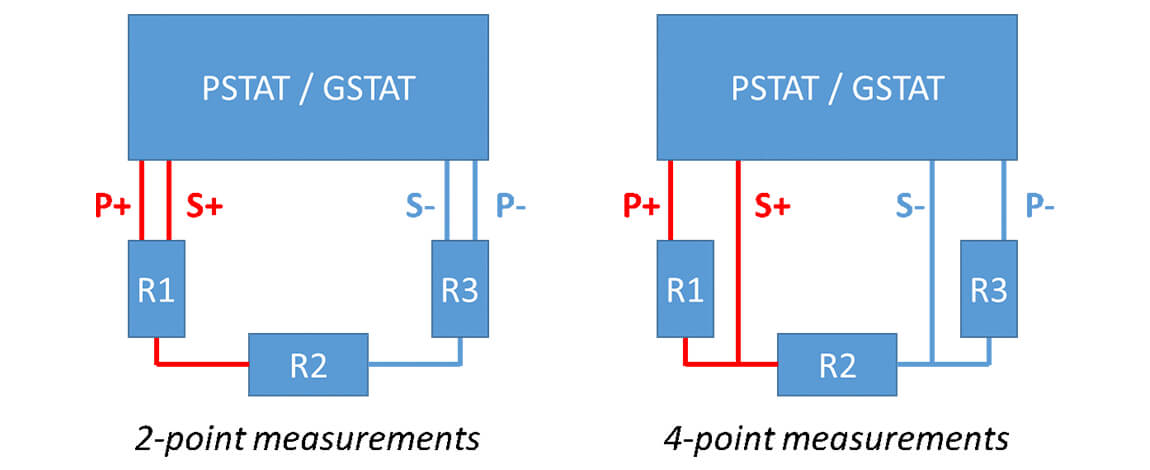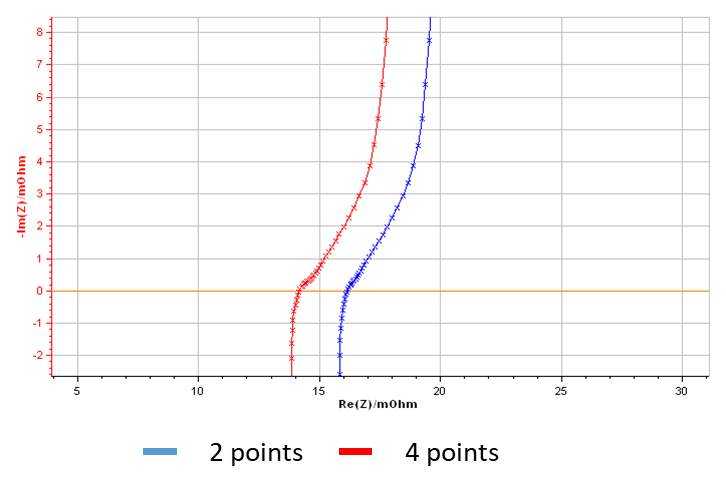Why 4-point measurements?
Latest updated: June 2, 2023Whether you are a BT-Lab® or EC-Lab® user, the following article may prove useful for many areas of interest, but in particular those interested in battery characterization.
A potentiostat / galvanostat is an instrument that can control both the current and the voltage applied to a cell. For this purpose, BioLogic potentiostats require at least 4 cables:
- 2 power cables (P+, P-)
- 2 (or 3) senses (S+, S- with or without reference)
For current control mode (galvanostatic), the potentiostat directly delivers the current specified in the settings through the power cables. In this case, the senses are only used to measure the voltage of the cell and they are not a part of the regulation process. The current is modulated by an adjustment of the voltage applied on a shunt inside the instrument. This is the reason why the user has to select a specific current range in the potentiostat known as galvanostatic mode.
Note: as a demonstration, it is possible to connect a resistor directly to the power cables, and to short circuit the senses together (to avoid voltage fluctuations).
For voltage control mode (potentiostatic), the instrument applies a determined voltage between both power cables according to the cell-desired voltage. In this case, the senses are a part of the regulation: the system adapts the voltage applied between the power cables to obtain the desired voltage between the senses.
We’ve seen the position of the senses is decisive for the measurement or for the control of the cell under test. It is possible to use a 2-point connection between the cell and the potentiostat, but to guarantee qualitative experiments, a 4-point measurement is recommended.
A 4-point connection to an electrochemical device separates the current-carrying leads from the voltage-sensing leads. This ensures that there is no current passing through the voltage-sensing leads, or through connectors, cables, or connection interfaces with the potentiostat (extension cables, battery holders…).
Let us consider the following example. In this case, connection cables are considered as resistors R1 and R3, and the cell as a resistor R2 (Fig. 1).
Figure 1: Difference between 2 and 4-point measurements
If the instrument is in galvanostatic mode, using a 2-point measurement connection, R1 and R3 resistors induce an additional ohmic drop: the voltage measured is not the one of the cell, but the one resulting from the addition of the 3 resistors. If the instrument is in potentiostatic mode, the specified voltage is applied to the system (R1 + R2 + R3), and not to the cell.
On the other hand, 4-points measurements allow users to avoid these issues. The measurement or regulation is directly performed on the cell itself. Result differences between both connection mode can be seen on Fig. 2.
Figure 2: Nyquist diagram showing the impact of the ohmic drop induced by a 2-point measurement.
It can be seen that the connection interface adds an additional resistance of around 2 mΩ, which induces a shift of the blue curve to the right on the Nyquist diagram.
Additional information
The CCH-1 potentiostat accessory is a coin holder designed for 20 and 24 mm coin cells, with a maximum thickness of 3.2 mm. Its 4 point connection provides low connection impedance, necessary for accurate AC and DC tests. The CCH-8 is also available as it is a 8-position coin holder alternative to the CCH-1.
Related products
Related accessories

